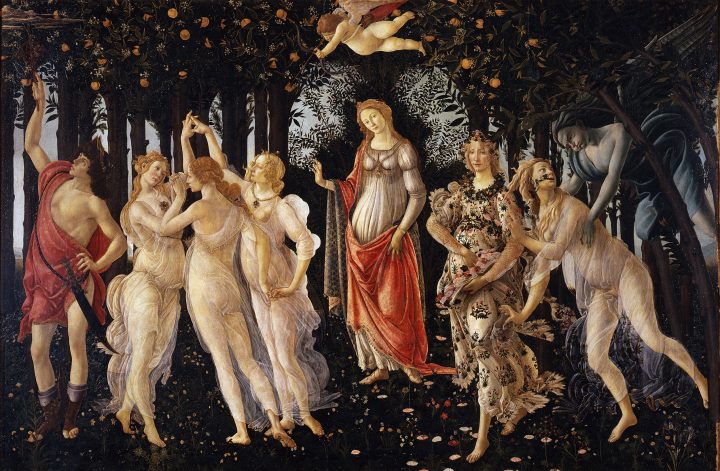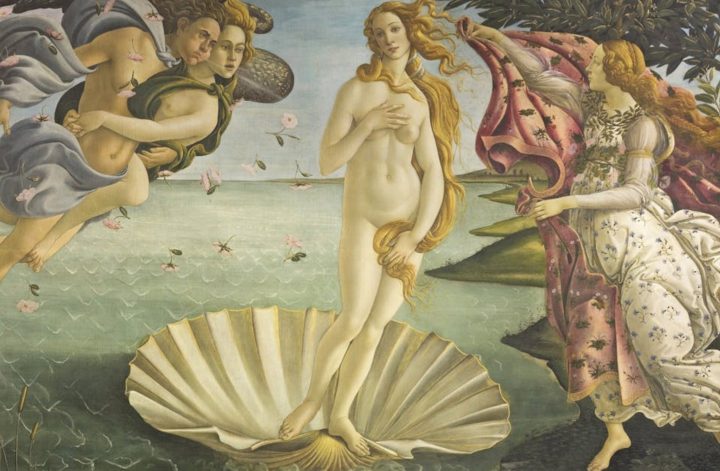By Mehreen Kabir
Date written: 17/12/2022
last updated: 4/13/2023
EARLY MIDDLE AGES
476 AD – 1000 AD
The Early Middle Ages, also known as The Dark Ages, was a period of instability in Europe after the fall of the Western Roman Empire and is known as such because of the lack of records from that time period. However, plenty of artworks survive today, allowing us to glimpse the cultures and traditions of more than a millennia ago.
Byzantine art
While the Western Roman Empire was declining, the Roman emperor Constantine I moved the Roman capital from Rome to Constantinople, the site of the old Byzantium1. As a result, art from that time period had more influence from eastern artworks, particularly Byzantine art. Byzantine art was characterized by a flat look to the artworks with rather unrealistic poses and anatomy; a far cry from the almost human-like statues of the Western Roman Empire. As a matter of fact, there was barely any sculptural work as the Bible prohibited the creation of three-dimensional forms of living things.
Left: A Roman fresco from Pompeii showing a Maenad in a silk dress, 1st Century C.E – Image via Wikimedia Commons
Right: Virgin (Theotokos) and Child between Saints Theodore and George, 6th Century C.E – Image via Wikimedia Commons
From the pictures above, it is clear that art had changed drastically during the shift of Rome’s capital to the East. While Roman Art had a much more realistic approach to the human body, Medieval art was more abstract, with a flatter look and somewhat unrealistic poses.
There are many possible reasons as to why Byzantine art was so different from its Western Roman counterpart despite the people of the Byzantine Empire identifying as Romans. The biggest one is probably that the people of the Christian Byzantine Empire wanted to distinguish themselves from the pagan Western Roman Empire. They saw the creation of busts and lifelike statues as a form of idolatry and thus refrained from it. Byzantines also believed that a spiritual being should not be depicted as a human and that there should be a symbolic approach to them instead. Byzantium was also closer to the Muslim empire, and Muslims prohibited the creation of any human forms. The practice may have spread to the Byzantine Empire to some extent.
Christ Pantocrator of St. Catherine’s Monastery at Sinai, 6th Century C.E – Image via Wikimedia Commons
Christ Pantocrator of St. Catherine’s Monastery at Sinai is widely regarded as one of the most important Byzantine artworks, dating back to the 6th century CE2. It is widely believed that his face was made asymmetrical on purpose; with the side holding the Gospel showcasing his human attributes, and thus having a harder expression and a stronger emphasis on light and shadow. On the other hand, the side where he is raising his hand showcases his divinity, thus the minimal shadow placed on his face and the calmer expression.3
The shift of the capital of the Roman Empire to Byzantine was responsible for fusing cultures of the West and East; and of course, art was no exception, taking inspiration from Celtic and Anglo-Saxon patterns from the West and its iconoclastic values from the East.4
Anglo-Saxon & Insular Art
7th century – 1066 C.E
The terms anglo-saxon and insular are often used interchangeably, however, they do have slight differences, the biggest one being that Insular art had more Celtic influences than Anglo-Saxon art. However, both Anglo-Saxon and Insular art had noticeable Celtic influences, as most of the institutions where manuscript illumination took place were largely an extension of the Irish monastic system.
The use of Celtic elements throughout the illuminated manuscripts of the Lindisfarne Gospels, 715-720 C.E.
– Image via Wikimedia Commons
Created in the early 8th century, The Lindisfarne Gospels are widely credited as one of the most spectacular manuscripts of Anglo-Saxon England. It is one of the greatest examples of Insular art, combining Anglo-Saxon and Celtic elements.5
Prior to the spread of Christianity across Northern Europe, pagan art only contained intricate and abstract patterns as opposed to representations of the human body. Later, the addition of human forms was adopted from Southern Europe. However, the style in which they were drawn remained largely unchanged: With flat colours and surrounded by complicated patterns.
An example of the Anglo-Saxon depiction of human forms from the Lindisfarne Gospels, 715-720 C.E – Image via Wikimedia Commons
Here, we can see that Anglo-Saxon or Insular art used flat depictions of the human figure, which fell conveniently in line with Byzantine’s Christian beliefs as well as Northern Europe’s pagan art styles of the past. There is a great deal of irony in this situation as Byzantine art had likely adopted their flat depictions to distinguish themselves from pagan societies of Southern Europe, only to fit in with pagan art forms of another region.
The lavishly decorated designs of the Book of Kells – Image by Wikimedia Commons
The Book of Kells is a great example of Insular art, with its heavy decorations and emphasis on abstract designs rather the human form.
Early anglo-saxon and insular art depicted one of the biggest transitional periods in history: Norther Europe’s transition from a pagan society to a Christian one. However, as depicted in Insular art, artists of the time still held on to their traditions even as their beliefs shifted, resulting in a unique mixture of the old and new.6
Carolingian Renaissance
The Carolingian Renaissance was the first of the three medieval Renaissance periods, lasting from 780-900 C.E. It was instigated by Charlemagne, who took inspiration from Constantine’s legacy of military strength and artistic patronage. This period was marked by cultural and intellectual revival, reminiscent of the Renaissance that was to come more than 500 years after.
St. Mark from Ebbo Gospels, C.E. 816-35 – Image via Wikimedia Commons
The Ebbo Gospels, created after the beginning of the Carolingian Renaissance, show a style distinctive from the previous flat styles of the Byzantine Empire. Artworks in the Carolingian period sought to restore the 3rd dimension and bring back some of the realism from classical culture.
A page of the Codex Aurelius of St. Emmeram depicting Charles the Bald, C.E. 870 – Image via Wikimedia Commons
Here, we can see a similar attempt to make the artwork more realistic through the use of more contrast in shading and more accurate folds in clothes. The manuscript had also been decorated more lavishly, with the entire page being colored and decorated.
Left: An illustration from Drogo Sacramentary, a Carolingian manuscript created in C.E. 850 – Image via Wikimedia Commons
Right: A close-up on the breastplate of Augustus of Prima Porta, a full-length portrait statue created in 20 B.C.E – Image via Wikimedia Commons
From the artworks above, we can see the resemblance between the art style of Drogo Sacramentary and the relief work done on the breastplate of Augustus of Prima Porta — despite them being of different religions and created with entirely different mediums.
Under the Carolingian Renaissance, a new emphasis was placed on education, culture and knowledge. The Carolingian period set the stage for the next two medieval Renaissance periods to come in the following centuries.7
Ottonian Renaissance
936-1002 AD
The Ottonian Renaissance began with the reign of Otto I in 936 AD and ended with the reign of Otto III in 1002 AD. Each Ottonian king was determined to define themselves as a Roman emperor, taking inspiration from Constantine I and Charlemagne. Because of this, they created an extensive artistic and cultural legacy similar to those of the Roman emperors. However, unlike the Carolingian Renaissance, Ottonian art took more inspiration from Northern and Eastern Europe, as well as Byzantine art as opposed to Classical art. This resulted in an increased number of abstract elements, taking inspiration from Anglo-Saxon art.8
Symbolic Crucifixion from the Uta Codex, C.E. 1002-25 – Image via Wikimedia Commons
The Ottonians held mathematics and sciences in high regard, and this can be seen in the geometrical designs of the time period, carefully balanced to depict harmony. Notice the high use of gold in the designs, a practice that would go on to be continued into the Romanesque art movement.
Ottonian art took more influence from Byzantine art than Carolingian art had, especially as Otto II had been married to Theophano of Byzantium9, effectively bringing Byzantine culture back to mainstream European art.
“Roma”, “Gallia”, “Germania” and “Sclavinia” pay homage to Otto III, from the Munich Gospels of Otto III, one of the “Liuthar group”, created in about 1000 C.E – Image via Wikimedia Commons
Here, we can see that Ottonian art goes back to the flattened silhouettes of Byzantine art, as well as a more abstract style.
The Annunciation to the Shepherds from the Pericopes of Henry II, “Liuthar group” of the “Reichenau school” – Image via Wikimedia Commons
The above artwork clearly did not intend to use perspective in a realistic way. Instead, the sizes of the characters varied depending on how important the figure was to the story depicted by the artwork.
In many ways, the Ottonian Renaissance was a complete change in direction from the Carolingian Renaissance. While the Carolingian Renaissance attempted to bring back Classical art, the Ottonian Renaissance took more inspiration from Byzantine and Anglo-Saxon artworks. However, enthusiasm for art and literature in the Ottonian Empire had grown to be much more prominent since the early Byzantine Empire, slowly paving the way for the Renaissance of the 12th century.10
Conclusion
The early middle ages marked both a transition of power after the fall of the Roman Empire as well as a transition of religious beliefs. Art during this time period was unlike anything ever seen before and set the course for many changes yet to come.
Bibliography
- 1Wasson, Donald L. “Constantinople.” World History Encyclopedia, Https://Www.worldhistory.org#Organization, 4 Aug. 2022, https://www.worldhistory.org/Constantinople/.
- 2John Galey, George Forsyth, and Kurt Weitzmann, Sinai and the Monastery of St. Catherine (Givatayim, Israel: Massada, 1980), 99.
- 3Weitzmann, Sinai, the Icons, 15.
- 4“Beginner’s Guide to Byzantine Art & Mosaics (Article).” Khan Academy, Khan Academy, https://www.khanacademy.org/humanities/ap-art-history/early-europe-and-colonial-americas/medieval-europe-islamic-world/a/byzantine-artintro.
- 5Hull, Derek (2003). Celtic and Anglo-Saxon Art: Geometric Aspects. Liverpool: Liverpool University Press. ISBN 0-85323-549-X.
- 6Anglo-Saxon Art.” Encyclopædia Britannica, Encyclopædia Britannica, Inc., https://www.britannica.com/art/Anglo-Saxon-art.
- 7Dr. Nancy Ross, “Carolingian art, an introduction,” in Smarthistory, July 6, 2018, accessed July 17, 2022, https://smarthistory.org/carolingian-art-an-introduction/
- 8“Ottonian Renaissance.” Encyclopedia.com, Encyclopedia.com, https://www.encyclopedia.com/religion/encyclopedias-almanacs-transcripts-and-maps/ottonian-renaissance.
- 9“Theophano Of Byzantium (C. 955–991).” Encyclopedia.com, Encyclopedia.com, https://www.encyclopedia.com/women/encyclopedias-almanacs-transcripts-and-maps/theophano-byzantium-c-955-991.
- 10Valdes, Victoria, and Victoria Valdes. “Ottonian Art, an Introduction.” Smarthistory, https://smarthistory.org/ottonian-art-an-introduction/.
cover images: The coronation of Otto III.



